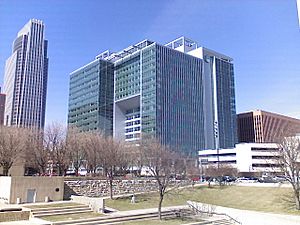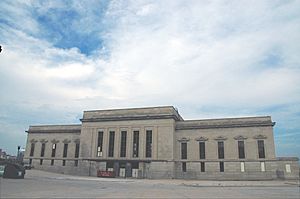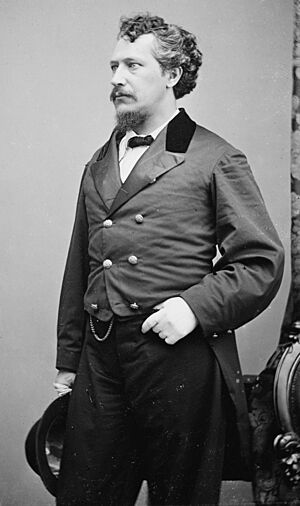Railroads in Omaha facts for kids
Railroads have played a huge part in making Omaha, Nebraska what it is today. They helped the city, the state of Nebraska, and the entire Western United States grow. It wasn't a planned strategy, but many different railroad companies ended up coming to Omaha, making it a major hub.
Contents
History of Omaha's Railroads
Omaha wasn't originally meant to be the starting point for the First transcontinental railroad. That honor was supposed to go to Council Bluffs, Iowa, just across the Missouri River. In 1862, President Abraham Lincoln signed a law creating the Union Pacific Railroad. This company was supposed to build a railway line west from a specific point in Nebraska.
However, in 1863, President Lincoln chose Council Bluffs as the official starting spot. But Thomas C. Durant, the first boss of the Union Pacific, decided to start the railroad in Omaha instead.
Building the First Transcontinental Railroad
Work on the First Transcontinental Railroad began in 1863 near the Missouri River in Omaha. A local businessman named Edward Creighton and a promoter named George Francis Train were very important in getting the railroad to start in Omaha. Train became very rich because he owned land near Deer Park, and its value shot up when the railroad came through.
The Union Pacific Railroad has had its main office in Omaha since 1867. Their historic Overland Route still runs through the city today. In 1872, Union Pacific opened the first bridge across the Missouri River, connecting Omaha to Iowa.
Railroads and the Omaha Stockyards
The Omaha Stockyards opened in the 1880s and became a massive center for livestock. To serve these stockyards, the South Omaha Terminal Railway was built. Because of the stockyards, Omaha became a hub for almost every major railroad in the country by the 1880s.
Other railroads that served the city included the Omaha Road and the Omaha Southern Railroad. The U.S. Army also built the Omaha Quartermaster Depot in 1881. This depot used the many railroads to supply military bases across Nebraska and the Western United States.
By 1955, Omaha had become the world's largest center for stockyards and meatpacking. Thousands of animals were processed each week. Most of these animals came from 22 states, mainly by train.
The Omaha Belt Line
The Omaha Belt Line was a 15-mile (24 km) long railroad that went around the city. It started in 1885 and carried both people and goods. The Missouri Pacific Railroad operated this line. The Belt Line also had branches that went to other Nebraska cities like Lincoln and Nebraska City. This railroad line stopped running in the early 1960s.
Early Public Transportation
In 1867, the Omaha Horse Railway started, offering the city's first horse-drawn streetcars. Later, the Omaha Cable Tramway Company introduced cable cars in 1884. This was the city's only cable car system, and it ran until 1895. It then joined with the Horse Railway to form the Omaha Street Railway Company.
By 1901, Gurdon Wattles brought several smaller companies together to create the Omaha and Council Bluffs Streetcar Company. This company built a large public transportation system that covered the whole city. It included commuter trains and interurban lines, which are trains that connect cities. Streetcar lines operated in Omaha until 1955.
Omaha's Train Stations
By 1898, Omaha had two very important train stations. The Union Station was used by many different railroads, including the Union Pacific Railroad. It also served as the Union Pacific's main office.
The architect Gilbert Stanley Underwood designed Union Station in 1931. He wanted the building to show the railroad's strength and power. It was the first Art Deco style train station in the United States.
The Burlington Station was used by the Chicago, Burlington and Quincy Railroad and later by Amtrak. Other stations in Omaha included the Florence Depot and the North 34 Street Station.
Former Train Stations
Over the years, Omaha has had many train stations, both large ones downtown and smaller ones in different neighborhoods.
| Name | Location | Opened | Closed | Notes |
|---|---|---|---|---|
| Burlington Station | 925 South 10th Street | 1898 | 1974 | Now home to KETV 7. |
| Briggs Station | 5300 Sargent St | |||
| DeBolt Station | 7000 North 60th Street | |||
| Druid Hill Depot | North 32nd and John Creighton Boulevard | 1888 | Unknown | Was on the Belt Line Railway. |
| Florence Depot | 9000 North 30th Street | 1887 | 1966 | Now a historical museum. |
| Gibson Station | ||||
| Lake Street Station | North 40th and Lake Streets | 1887 | Still standing | |
| Missouri Pacific Freight Depot | North 14th and Webster Street | |||
| Nicholas Street Depot | North 43rd and Nicholas Street | 1887 | ||
| Nicholas Street Freight Depot | North 15th and Nicholas Street | 1887 | ||
| Oak Chatham Depot | 4351 North 22nd Street | 1887 | ||
| Ralston Station | ||||
| Union Station | 801 South 10th Street | 1938 | 1971 | Now the Durham Western Heritage Museum. |
| Union Stockyards Depot | South 28th and L Streets | Station for the South Omaha Terminal Railway. | ||
| Walnut Hill Depot | Military Avenue and Hamilton Street | 1887 | ||
| Webster Street Station | Webster and Saddle Creek Road | 1887 | ||
| West Lawn Station | Aksarben Drive and Mercy Road | Was on the Chicago and North Western Railroad. | ||
| Walnut Hill Station | 34th and Nicholas Street | |||
| South 28th and B Streets |
Railroad Bridges
Omaha has many bridges, called trestles, that carry railroads over roads and other structures.
| Name | Location | Opened | Closed | Notes |
|---|---|---|---|---|
| Union Pacific Missouri River Bridge | Across the Missouri River | |||
| East Omaha Bridge | Across the Missouri River | 1893 / 1903 | 1980 | Built by the Illinois Central Railroad. |
| O Street Viaduct | O Street | 1885 / 2001 | ||
| Cuming Street Trestle | 4448 Cuming St | 1887 | Built for the Belt Line Railway, now gone. | |
| North 30th Street Trestle | 4900 N. 30th | Owned by the Chicago and Northwestern Railroad, now gone. | ||
| OPPD Trestle | 41°19’39.1″N 95°56’25.6″W | Built for the Omaha Public Power District, now gone. | ||
| Omaha Road Trestle | 41°19’37.2″N 95°56’58.4″W | Built by the Omaha Road. | ||
| North 16th Street Trestle | 4140 N. 16th Street | 1887 | Built for the Belt Line Railway, now gone. | |
| Union Pacific Carter Lake Bridge | 4405 Carter Lake Shore Dr. West | Now gone. | ||
| Missouri Pacific Carter Lake Bridge | 35 Carter Lake Shore Drive | Now gone. | ||
| Union Pacific Missouri River Bridge | Across the Missouri River | 1893 / 1903 | ||
| Union Pacific Missouri River Bridge | Across the Missouri River | 1893 / 1903 |
Because of agreements, railroad companies in Omaha were responsible for building and taking care of many overpasses. These allowed wagons, cars, people, and streetcars to travel over the train tracks safely.
Railroads in the 20th Century
In 1939, a big Hollywood movie called Union Pacific was shown in Omaha. It celebrated the city's rich railroad history. Also, a special self-moving passenger car called the McKeen railmotor was made in Omaha.
Railroads remained very important for moving goods, for businesses, and for people traveling throughout the 20th century. By 1947, Omaha's two main stations had 114 passenger trains every day. These trains connected Omaha to places all over the West and Midwest.
Trains also carried tens of thousands of animals to the meatpacking plants near the stockyards. By the mid-1950s, Omaha's stockyards and meatpacking industry were the biggest in the world, even larger than Chicago's.
Railroads in the 21st Century

Today, the Omaha Rail and Commerce Historic District celebrates Omaha's railroad past. The Burlington Train Station and the Union Station are listed on the National Register of Historic Places. You can also see two huge train engines in Kenefick Park in South Omaha. They face Interstate 80, which is now a major way people and goods travel.
Many big railroads used to serve Omaha, including the Rock Island, Burlington & Quincy, and Missouri Pacific.
However, like many cities, Omaha saw a big drop in passenger train service in the second half of the 20th century. Amtrak took over most passenger service in 1971. By the 1980s, only three Amtrak trains served Omaha. Today, only the California Zephyr train still stops in Omaha, connecting it to Chicago and California.
Omaha is still home to the main office of the Union Pacific Railroad. The Union Pacific Center downtown is the largest building in Nebraska by size and the fourth tallest in Omaha.



